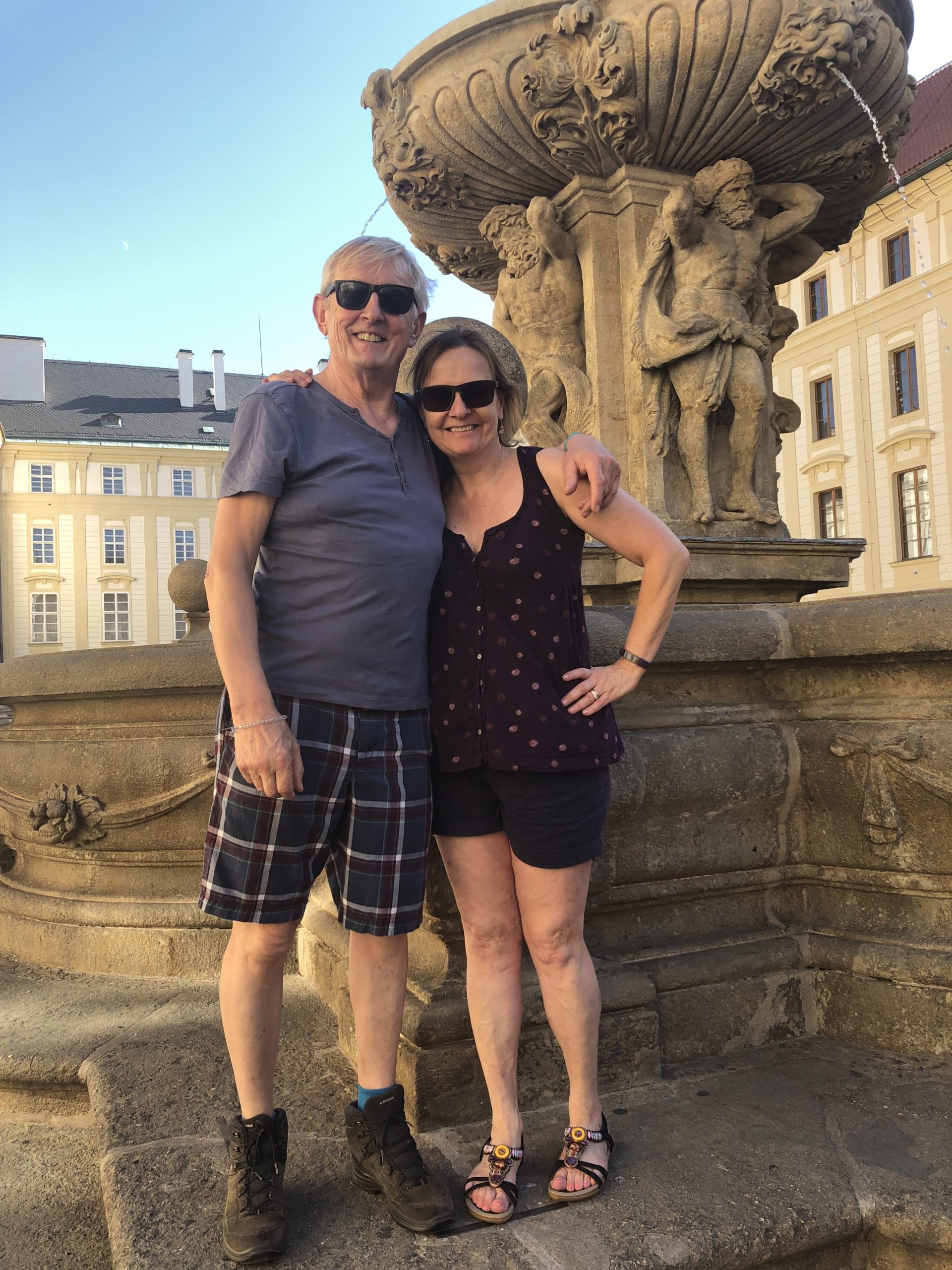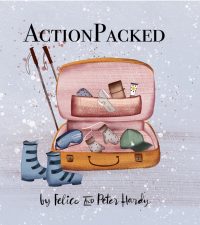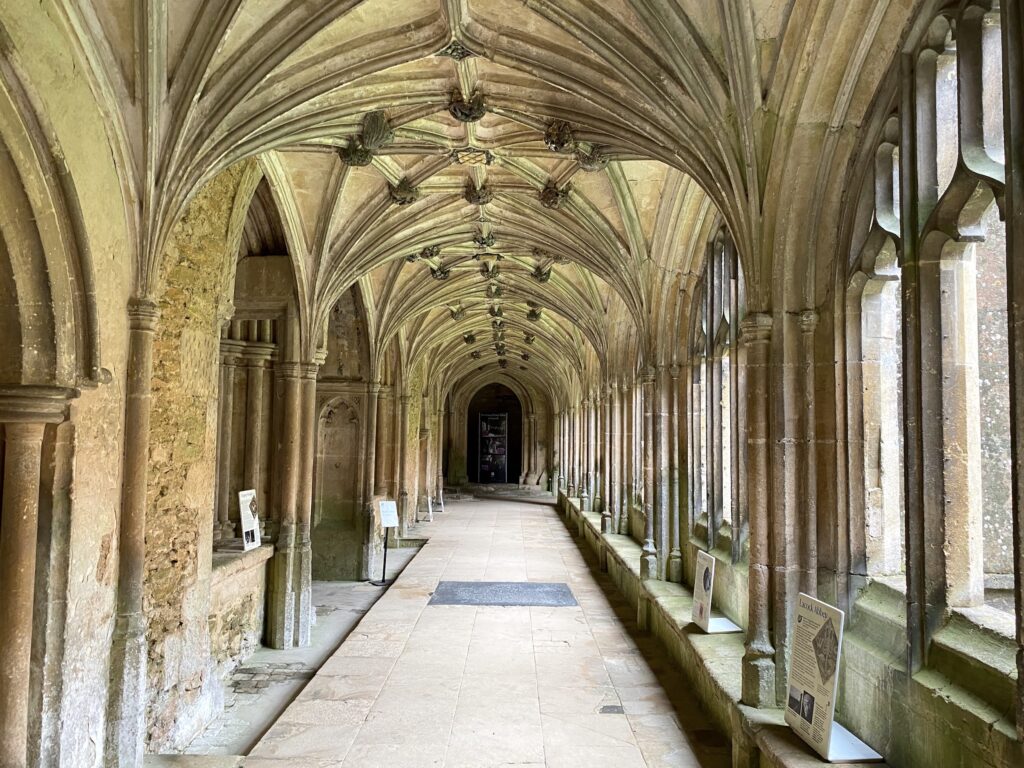
The cloisters, where parts of Harry Potter was filmed. Photo: © F.Hardy
Peter Welcome to our travel podcast. We’re specialist travel writers and we’ve spent half a lifetime exploring every corner of the world.
Felice We want to share with you some of our extraordinary experiences and the amazing people we’ve met along the way.
Peter Today we’re in what was originally a 13th-century abbey, gazing out through the lattice panes of a bay window. The view of the countryside here in Wiltshire in the west of England is a fine one, but that’s not what we’re here for. No, we’re here for the window itself because it’s the shaft of light that streamed through it on an August day 186 years ago, that changed our whole world forever.
Felice We’re in the ancient village of Lacock. This quaint medieval community, with its cobbled streets and A-framed cottages and coaching inns set around a tumbling stream, seems rather familiar.
Peter As you walk around each street corner, vague memories, historical snapshots if you like of assorted unrelated costume dramas, vie for conscious recognition. Perhaps we’ve been here before in another life?
Felice Of course, we have been here before, not in a previous life but in this one – through cinema, movie theatre and TV screens.
Peter Yes, in Pride and Prejudice, Colin Firth stole the hearts of a generation of Jane Austen fans. Scenes from Downton Abbey were also shot in Lacock, which is now used regularly as a film set.
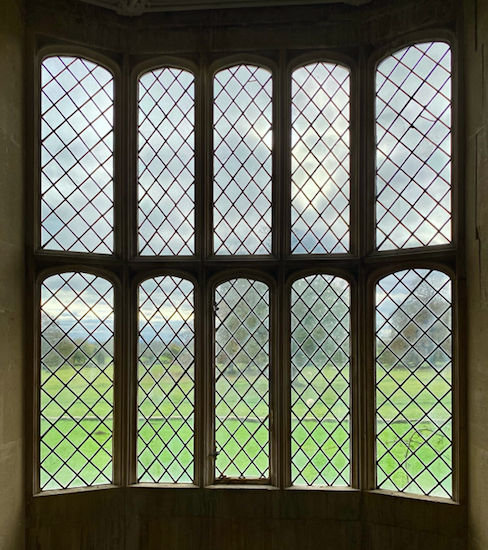
The Oriel window. Photo: © F.Hardy
Felice But none of this would have happened without that Oriel window of Lacock Abbey. In the wake of his dissolution of the monasteries, Henry VIII sold it off as a private family home. The building and almost the whole village is owned these days by the National Trust. Clare, our guide to the Abbey, took us inside.
Clare So the house is currently closed for the winter, although we will reopen the Great Hall for Christmas, but I’m going to take you through into the cloisters, which is open all year round and is one of the areas where parts of Harry Potter were filmed. This would be normally where you come in – through the main door and into the Great Hall.
Peter This is the Great Hall, a magnificent building with an enormous Tudor fireplace, blackened by time and smoke…quite austere, but then you would expect that in an abbey.
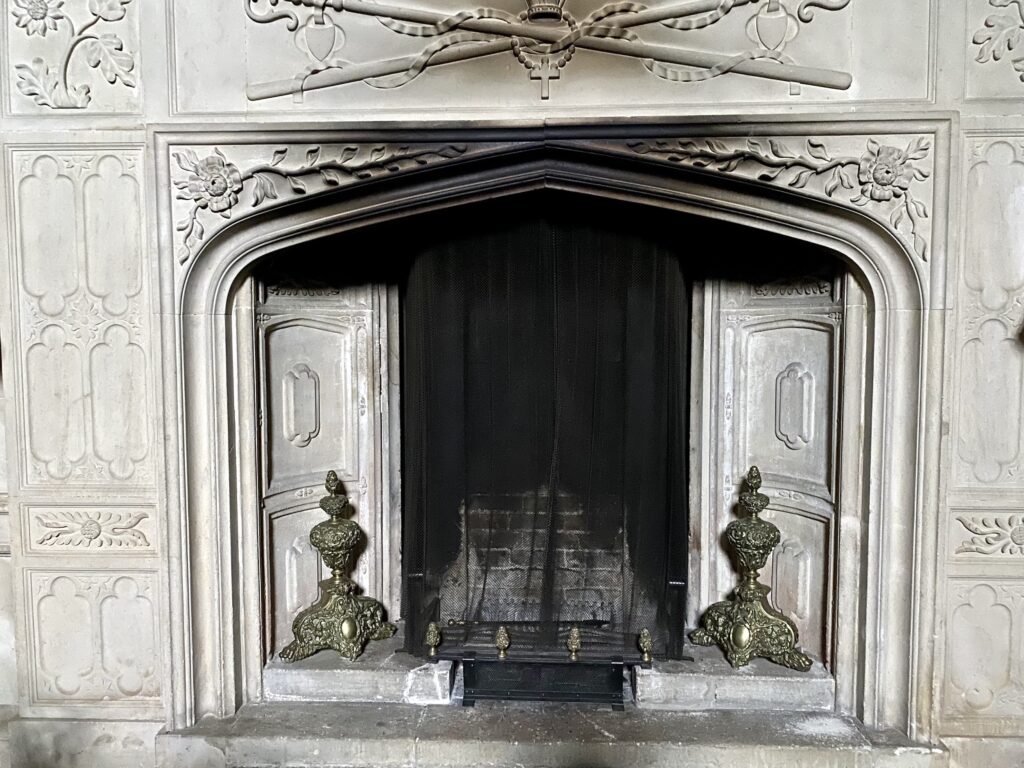
The Tudor fireplace. Photo: © F.Hardy
Clare So the Great Hall was built by John Ivery Talbot in the 18th century. The Great Hall is filled with terracotta statues, and there are two in particular to look out for. The first one is above the fireplace – the central one, which is the statue of Ella, the founder of the Abbey. And the second one is on your left as you come in, and you will see a goat with a sugar lump on its nose.
Peter That’s a pretty unusual thing to see.
Clare So the sugar lump was put there in 1919 by a student who was staying at the Abbey, as a practical joke. But we’ve kept it there ever since.
Peter Same sugar lump?
Clare Not quite!
Peter So this is a pretty important window we have here?
Clare Yes, this is in the South Gallery, which was used as a living room in the early 19th century, and this latticed window is what revolutionised the way that we see the world.
Peter On August 22nd, 1835, probably around mid-morning on what was a wonderful hot summer’s day, the scientist-owner of the Abbey set up his primitive wooden camera on the mantel shelf opposite this window. He first brushed a sheet of writing paper with table salt and silver nitrate, placed it inside the box, released the shutter and started an exposure that may well have lasted for hours.
The result, clearly showing the mullion frame of the window in light relief, is the earliest photographic negative to survive – and quite probably the very first negative ever to be shot. The photographer’s name was William Henry Scott Talbot, recognised now as one of the fathers of the photographic process.
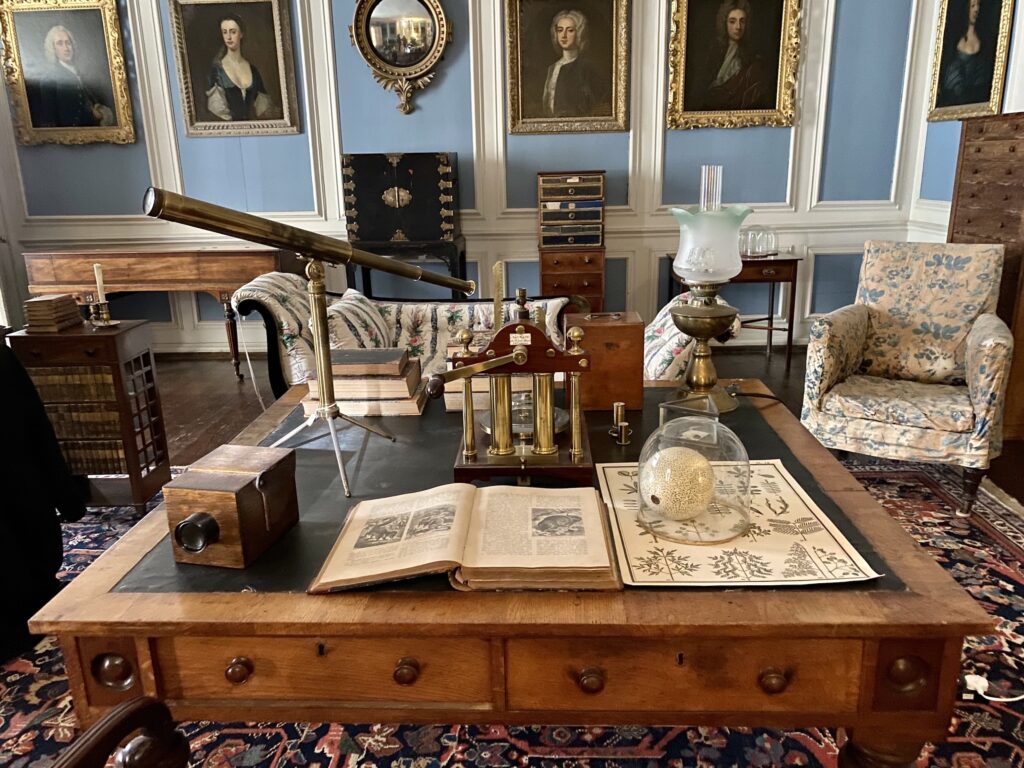
Fox Talbot’s study. Photo: © F.Hardy
Clare So this is the Blue Parlour, which was William Henry Fox Talbot’s private study. He used to work long into the night here on all of his many and varied interests. He was fascinated by astronomy, by botany, by chemistry, by all kinds of scientific and artistic subjects.
Peter Photography is what would always remember him for.
Clare That’s certainly true.
Felice Yes, but as he wrote in 1839, that’s four years later: “I do not profess to have perfected an art, but to have commenced one, the limits of which it is not possible at present to ascertain. I only claim to have base this new art upon a secure foundation. It will be for more skilful hands than mine to rear the superstructure.”
Peter So now we’re in the cloister, which is the North Cloister Walk, which is a remarkable colonnade with a lawn in the middle.
Felice This is the one that’s connected with Harry Potter?
Clare Yes, there was a lot of filming here, and I’ll take you through to the warming room and show you the cauldron that everybody believes is a stage prop and is actually the real thing.
Peter Now very Harry-Potter-like we’ve found ourselves beside an enormous cauldron.
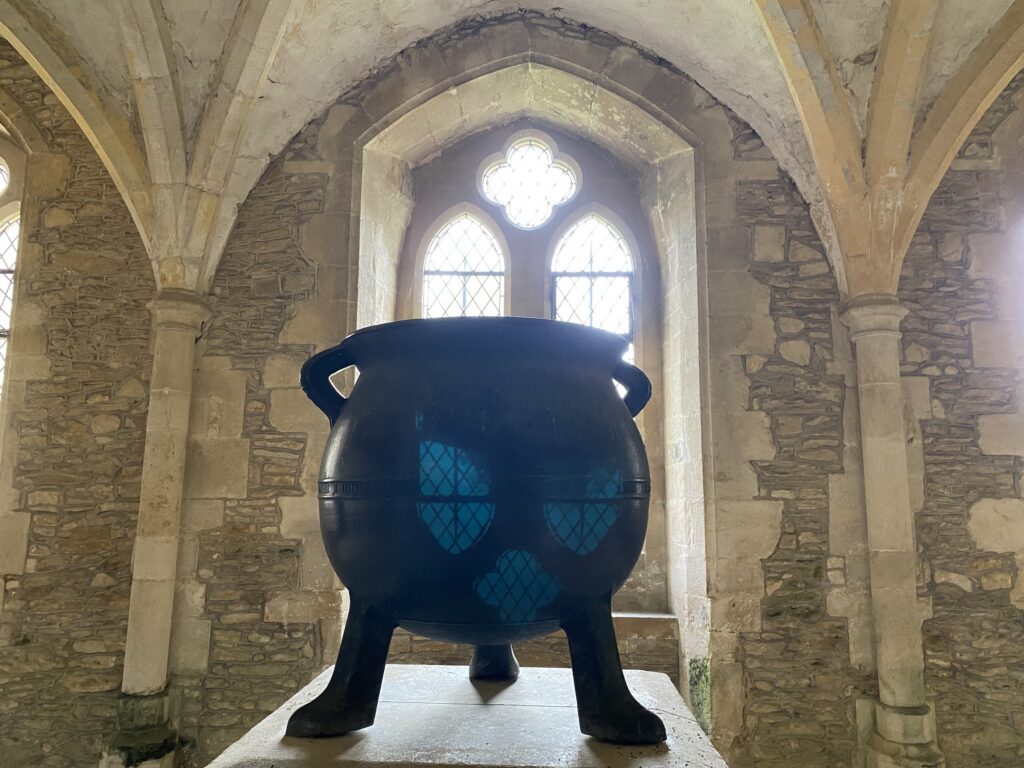
The cauldron. Photo: © F.Hardy
Clare This cauldron is made was made in the 1500s in Antwerp. We don’t actually know why it came to Lacock, but we do know that it was used for cooking and local legend says that it was used during a visit of Queen Anne in the early 1700s, when a side of pork and a sack-load of peas were cooked in it.
Peter I hope they cooked them for a long time.
Clare I hope so, too.
Felice So did that appear in the film?
Clare Yes. So within the warming house, this was a very popular place with the nuns as it was the only room they used which had a fire. And the nuns were allowed a fire between All Saints Day, which is the first of November, and Good Friday and you can still see the remains of the large hooded fireplace on the left of the doors you go in.
Peter So tell us about William Sharrington?
Clare So Sir William Sharrington was a Tudor courtier and a man on the make. He was also a master of the Bristol Mint, and he embezzled money from from the Mint and was done for fraud. He bought Lacock Abbey after the dissolution of the monasteries and turned it into a Tudor house, a Tudor family home. But unusually for the time, he kept a lot of the monastic elements, such as the cloister, which you can now walk around.
Peter Thank you, Clare. We’ll now leave you here at the Abbey and take a stroll, I think, around the village. We’ve arranged to meet up with Lynda, a local woman who’s lived here for many, many years, and she’s going to show us around and tell us a little bit about the history of the village.
Peter Lacock is an ancient settlement. People have been living in this area for 3,000 years ever since the Iron Age. How do we know that, Lynda?
Lynda We know that because there’s an Iron Age fort at the top of Nash Hill. We know that the Romans were here because our southern boundary is a dead straight line that follows a Roman road. We know the Saxons were here because Lacock or La Cook is a Saxon word that means a small stream – or a settlement alongside a small stream. We know the Normans were here because we have an entry in the Doomsday Book: 1086. We also know that William the Conqueror visited Lacock in the run-up to the Doomsday Book. It’s in Norman Chronicles, and he visited his lords and bishops while they were compiling the Doomsday book.
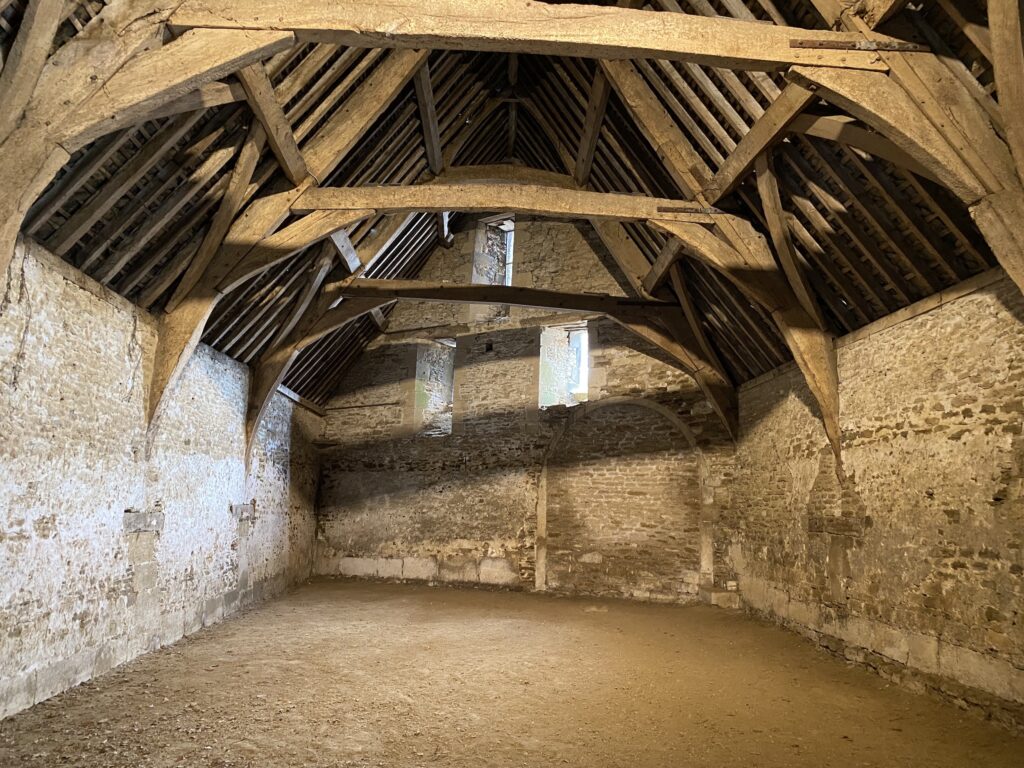
Inside the Tithe Bar. Photo: © F.Hardy
Peter So Lynda, here we are inside the Tithe Barn. Tell us about it?
Lynda The Tithe Barn is 13th century and was built just after the Abbey and tithe is a Latin word that means a tenth, and it’s where the villagers would have come to pay their rent – a tenth of their income. It wouldn’t necessarily have been in money. It might have been in meat or eggs or vegetables from their gardens. But the Tithe Barn had had many changes over the centuries. It’s been a market hall; it’s been a place for social gatherings for the people of the village.
Felice It’s amazing. It’s huge, very well preserved.
Peter Yes, a magnificent king post; it’s a magnificent building, beautifully maintained and restored.
Lynda The prominent houses are on either end of the high street and the one in front of us is the Red Lion. This was built to replace the old Red Lion that was pulled down. This was built in 1730 and is red brick.
Peter Yes, that looks very unusual.
Lynda It is unusual. But the reason is that in 1730, when it was built, bricks had to be made and transported from elsewhere in the country and were expensive. Stone was dug out of the quarries nearby in Bath and was cheap. So in fact, the red brick was done for status. The sides and the back are stone, so it’s only the front, the facade, that is red brick.
Felice And I think it was used for filming, wasn’t it?
Lynda Pride and Prejudice, which is 28 years ago.
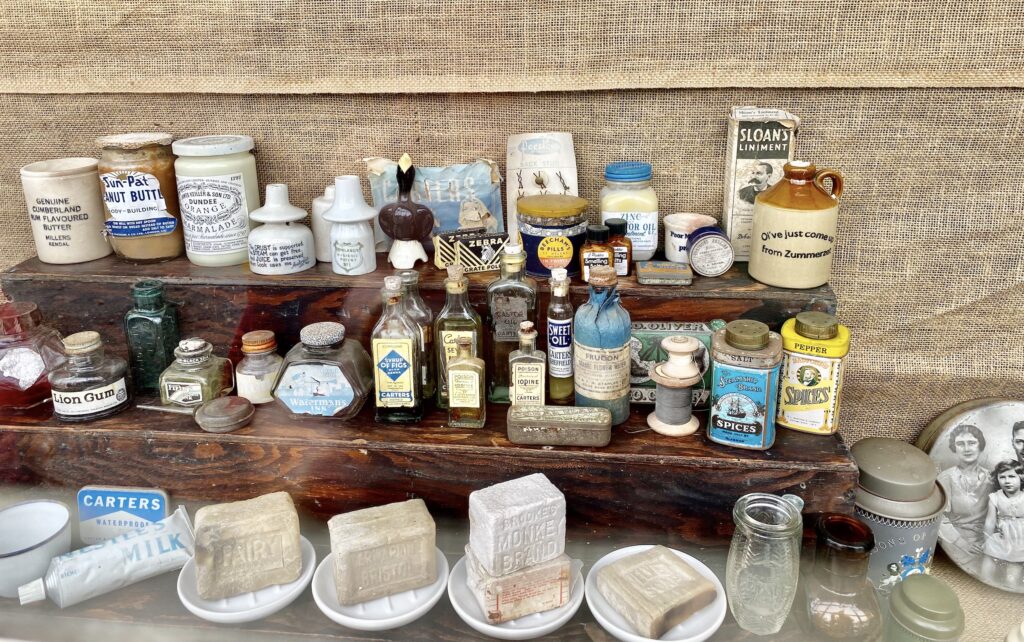
The old postmistress’ shop. Photo: © F.Hardy
Peter So here we’ve come to the old postmistress’ shop or rather her home, I think it was both. And she left here in the 1980s, but what she left behind is a quite extraordinary collection of bits and pieces throughout the previous century.
Felice I should interrupt and say where it is. It’s next to the Red Lion pub on the high street. There’s some very quirky things in the window. There’s syrup of figs…
Peter I remember syrup of figs…
Felice Then tincture of iodine, with a sign saying ‘poison’ above it.
Peter And it’s obviously castor oil and Dundee Orange Marmalade in a glorious looking jar that you wouldn’t find today. Calvert’s Carbolic toilet soap, which looks like it’s probably Edwardian…the packet looks Edwardian.
Felice And there’s some soap out of the packet too, which looks very unpleasant, very old and rather mouldy but I’m sure they were nice once. And there’s Sloan’s Liniment, I don’t know what that’s for.
Peter Oh, Sloan’s Liniment…you rub it on for all aches and pains.
Felice There’s a biscuit tin with Queen as a child and Princess Margaret and their parents.
Peter And then when you actually peep further into the shop, you see a whole treasure trove of sweets and things like that really haven’t changed, probably since the 1950s. There’s Fox’s Glacier Fruit drops and Needler’s Butter Mint Drops and Trebor Giant Spearmint Imperials and Oaken fruit rock – remember those great big jars of sweets. And everything’s just been left as it was.
Felice Apparently when the last owner died, it was left exactly as it was, and that was in about the ’80s and nothing’s been done. And it’s a pity, really, because it’s a museum and yet I think people are allowed to go in twice a year. I think it could be a better display, bigger and better, and open to the public more because children would love seeing all of that.
Lynda This is the house that they blew up in the first Harry Potter film when his parents were blown up and Harry got his scar on his forehead.

The Potters’ cottage. Photo: © F.Hardy
Felice It’s next to the workhouse and the old tannery says ‘private’ on the gate. You can’t go in.
Lynda This is our workhouse – early date: 1833, before the actual poor law came in.
Peter Can you just explain what a workhouse is?
Lynda The church looked after the poor and the ill in the parish and in 1833 an actual house, the workhouse, was built to accommodate the poor and the ill. The one that you see in front of you: the ladies lived in one half, the gentlemen lived in the other half and the governor lived in the middle bit.
It’s not like Oliver Twist – a lot of local families would have been in the workhouse. They didn’t necessarily stay in the workhouse when they went in there. In the wintertime, when there was no food and it was cold, they would have gone into the workhouse. But in the summer, when there was work on the land and there was fresh food to be had, they would have gone back home.

The old workhouse. Photo: © F.Hardy
Peter So what’s your main impression of the place?
Felice It’s very pretty, it’s almost like a film set, which of course it is, because the houses are absolutely perfect. There’s no peeling paint or washing hanging out…obviously there wouldn’t be at this time of year, but it’s all very, very picturesque. The doors and windows are all painted the same colour, every single building in the village, and that’s a sort of National Trust greeny-blue colour, which is very attractive.
Peter Yes. As Claie explained, nearly all the village belongs to the National Trust and has done since 1944, when the Talbot family donated it to the nation.
Felice So everything’s beautifully looked after.
Peter I think there are only two private houses that were in private hands before 1944. All the other houses are tenants of the National Trust. I don’t know how you become a tenant here, do you?
Felice I think you apply to the National Trust. Supposedly you have to fit into what they want, so someone who’s going prepared to really look after the property, make sure that it looks good all the time.

An exemplary village. Photo: © F.Hardy
Peter I guess it’s a little bit like living inside a goldfish bowl because the number of tourists who come here in the summer months in particular is quite enormous.
Felice I mean, even today, which must be low season, there are coach loads of schoolchildren.
Peter …all looking around. Well, it certainly is like being on a film set. I mean, wonderful, mainly 18th century streets and little curio shops.
Felice There’s no litter anywhere; it’s all very clean. So, yes, it’s really worth coming for the day. There’s some good places to eat as well.

Sign of the Angel. Photo: © F.Hardy
Peter Yes, we’re just coming up now to the Sign of the Angel. That’s a wonderful name for a restaurant. We did actually eat there when we came here before; it was very good indeed. It’s an old inn, I guess. I’ve just learned actually today that the Sign of the Angeln sounds like it was something religious connotation to it, but in fact, an angel was a medieval coin, and I think that’s what it refers to.
Felice That’s interesting. So if you want to find out more, go to www.NationalTrust.org.uk and then you’ll be able to search for Lacock.
Peter So if you’d like to see some pictures of Lacock and the houses and the buildings we’ve been talking about, do go to our website. That’s www.actionpackedtravel.com
Felice That’s all for now. If you’ve enjoyed the show, please share this episode with at least one other person! Do also subscribe on Spotify, i-Tunes or any of the many podcast providers – where you can give us a rating. You can subscribe on Spotify, Apple Podcasts or any of the many podcast platforms. You can also find us on Twitter, Facebook and Instagram. We’d love you to sign up for our regular emails to [email protected]. And by the way, we just like to mention that if you take up our special offer to buy Water To Go bottles, we do earn a small commission; this helps with the production costs of the podcast. Until next week, stay safe.
© ActionPacked Travel

- Join over a hundred thousand podcasters already using Buzzsprout to get their message out to the world.
- Following the link lets Buzzsprout know we sent you, gets you a $20 Amazon gift card if you sign up for a paid plan, and helps support our show.


